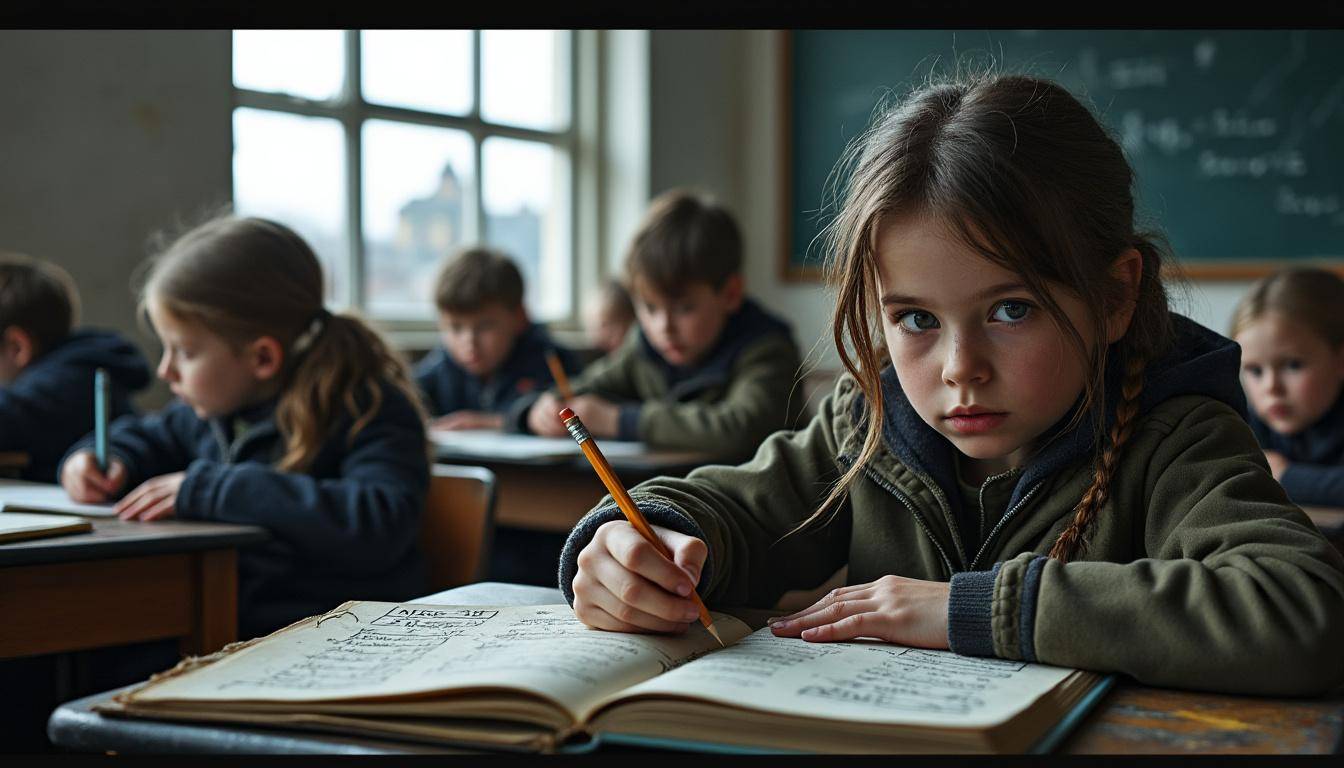Ukraine’s children confront a fourth school year amid invasion and widespread education challenges
As Ukraine enters its fourth school year under the strain of a full-scale invasion, the human story behind the numbers becomes central to any plan for recovery. For many families the day begins with an air raid alarm rather than a school bell. Yet, across towns and cities, children make their way—sometimes to basements, sometimes online—to keep learning. The scale is staggering: an estimated 4.6 million children face continuing interruptions to their right to education.
Consider the experience of a fictional pupil, Oksana, a 13-year-old living in a town near a frontline. Her school alternates between in-person lessons, sessions in an underground shelter, and remote classes when connectivity permits. Oksana’s family has been displaced once already, and the constant uncertainty affects her concentration and attendance. This vignette reflects millions of similar trajectories across the country and highlights how the war impact extends beyond physical damage to affect social and emotional development.
Daily disruptions and the mechanics of interrupted learning
Class routines have been altered: some institutions run double shifts, break times are shortened to reduce movement, and teachers must be flexible with content pacing. In many frontline areas schools remain closed due to safety concerns or insufficient shelter infrastructure. The consequences include increased absenteeism and a growing reliance on remote learning for approximately one million children.
- Interrupted schedules due to alarms and evacuations create fragmented learning blocks.
- Displacement forces children to switch curricula or lose continuity entirely.
- Infrastructure damage reduces the availability of safe, well-equipped classrooms.
The statistics are concrete: in 2025 alone, over 340 educational facilities were reported damaged or destroyed, and since the start of the full-scale invasion in 2022, international verification efforts have logged about 2,800 damaged schools—likely an undercount. These figures illuminate why access to education in a conflict zone remains precarious.
Addressing these challenges requires cross-sector engagement. Schools, parents, local authorities and international partners must work together to keep children like Oksana connected to learning pathways. Practical measures include mobile learning hubs, flexible assessment models, and catch-up programs. For educators and policymakers seeking comparative models, resources on integrating childhood health and educational strategies can offer useful perspectives, as shown by initiatives abroad such as in Michigan: Michigan childhood health and education link.
Key insight: The lived reality of millions of Ukrainian children shows that schooling in wartime is not only about buildings but about sustaining routines, relationships and hope under constant threat.
Protecting schools and safe learning in conflict zones: practical strategies for Ukraine
Protection of educational spaces emerges as a non-negotiable priority. Schools should be safe havens, yet in many areas they have become targets or collateral damage. The principle is straightforward: schools must be protected spaces where learning can continue even amid hostilities. Achieving this requires concrete measures across infrastructure, policy and community preparedness.
International organizations have emphasized that protecting education is an investment in the nation’s future. Practical steps range from reinforcing shelters and retrofitting classrooms to instituting alarm and evacuation drills adapted for children’s psychological safety. UNICEF’s combined efforts with governmental and local partners have helped more than half a million children access inclusive formal or non-formal education, showing how protection and programmatic support can restore learning continuity.
Operational protection measures and examples
- Physical reinforcement: conversion of basements into ventilated shelter-classrooms and installation of blast-resistant windows where feasible.
- Operational protocols: staggered schedules, shorter transitions and clear evacuation routes to minimize exposure during alarms.
- Policy frameworks: legal protection for schools and rapid response repairs funded through humanitarian pools.
Examples from field practice matter. In a regional center facing repeated strikes, a network of volunteer builders and educators collaborated to create a rota of safe learning spaces. These spaces used simple partitions, low-cost insulation and warm clothing distribution to keep sessions going during cold months. The result was not only continuity of learning but also a recovered sense of routine for students.
Furthermore, safeguarding curricula and teacher training are essential. Teachers in conflict-affected zones need modules on trauma-informed pedagogy and flexible assessment. Local school leaders reported higher attendance when teachers received training in psychosocial first aid and when schools offered small-group remedial sessions for students who missed months of instruction. To support teacher capacity and community engagement, initiatives on inclusive education and care planning are useful tools, such as the SEND education care resources: SEND education care plans.
Protection does not eliminate risk, but it reduces exposure and fosters resilience. International donors and civil society must prioritize quick repairs and pre-positioned learning kits during winter months to reduce interruptions.
Key insight: Investing in school protection and teacher preparedness converts fragile spaces into resilient learning centers that sustain children’s education through cycles of crisis.
Remote learning, displacement and practical approaches to restore access to education
When schools close or families are forced to move, remote learning becomes a critical bridge. Yet remote education is uneven: connectivity gaps, lack of devices and interrupted electricity make online schooling an imperfect substitute. Around one million Ukrainian children relied on remote learning arrangements during intense phases of the conflict, highlighting both the opportunity and the limitations of digital solutions.
Take Mykhailo, a 10-year-old whose family moved three times in a year. He attends a mix of asynchronous lessons and radio-based classes when internet access is unreliable. His teacher sends printed worksheets through local volunteers and coordinates small study circles in collective shelters. This blended approach demonstrates how combining low-tech and high-tech solutions can maintain progress.
Practical interventions to expand access
- Hybrid delivery: recorded lessons, radio/television broadcasts, and printed learning packs for low-connectivity households.
- Community learning hubs: solar-powered tents, mobile vans with tablets and rotating teacher visits in displacement sites.
- Parental and caregiver support: guidance materials that enable parents to reinforce learning, especially for younger children.
Interventions should be sensitive to displacement dynamics. IDP (internally displaced persons) camps require dedicated learning spaces and teacher incentives to serve transient populations. Integration of early childhood safety and learning also matters; models that link childcare with basic education services can keep younger children engaged while parents work or register for assistance. For program designers, comparative approaches to child-care integration provide useful frameworks: Child-care integration examples.
Technology is an enabler, not a panacea. Practical policies emphasize device sharing, community Wi-Fi points, and low-bandwidth content. Technical support hotlines and teacher-led WhatsApp study groups have proven effective in several provinces. Where feasible, partner organizations have deployed satellite connectivity to schools and training for teachers on producing engaging short videos and audio lessons.
Key insight: Blended, context-sensitive remote learning—backed by community hubs and low-tech options—can sustain access to education for displaced children and mitigate the immediate effects of school closures.
Psychosocial support, remedial education and the role of families and communities
Education in wartime must address both academics and emotional recovery. Children exposed to bombardment, displacement and loss require psychosocial support as part of their schooling. Remedial education plays a dual role: it helps students catch up on missed learning and provides structured social interaction that rebuilds trust and optimism.
UNICEF and partners have provided remedial programs and inclusive learning activities to more than 500,000 children, using catch-up curricula and small-group sessions. Financial assistance has also been targeted: during the 2024–2025 winter season, UNICEF reached 43,337 households, helping 140,234 people, including 63,416 children (of whom 30,738 were girls). In October alone, 22,557 households received winter cash support, enabling families to maintain heating and purchase learning materials.
Community-anchored psychosocial and remedial strategies
- Safe group activities that combine play, literacy and life skills to rebuild routines.
- Targeted remedial classes focusing on numeracy and literacy deficits from missed instruction.
- Parental engagement programs that equip caregivers to support learning at home under stress.
Parent and caregiver involvement is a decisive factor in children’s recovery. Programs that guide parents on daily learning routines, stress management and how to use provided learning kits yield higher retention. For educators tackling parental engagement, practical guidance can be found in resources such as strategies to navigate parental engagement.
Case studies from community schools show that combining psychosocial support with remedial teaching accelerates recovery. In one town, a local NGO trained volunteer youth as peer tutors, pairing them with younger children for twice-weekly sessions. Attendance stabilized and younger students regained confidence in reading after three months. These initiatives highlight the multiplier effect when communities invest time and social capital into learning recovery.
Key insight: Holistic recovery—combining psychosocial support, remedial education and strong family involvement—restores both learning and a sense of normalcy, making education an anchor for resilience.
Policy, international support and practical investments to secure education for Ukraine’s future
Long-term recovery requires policy coherence and sustained international investment. Protecting the right to education in a conflict zone is not optional; it is a strategic investment in the country’s future human capital. International partners must continue to fund emergency repairs, teacher salaries, learning materials and programs that prioritize inclusion for displaced and disabled children.
Policy measures should include rapid damage assessments, a prioritized list for repairs and a national catch-up curriculum that validates learning even when formal attendance is disrupted. Rebuilding must also encompass modernization: when schools are reconstructed, they should incorporate resilient designs, climate-adaptive features and safe play spaces. The intersection of education and broader policy agendas—climate, child protection and social services—adds resilience to reconstruction plans, as discussed in discussions on children’s education and global initiatives: children’s education and global policy link.
Concrete policy recommendations
- Prioritize rapid repair funds and safe learning kits to restore access within months, not years.
- Create incentives and protection for teachers who work in high-risk areas, including psychosocial supports and hazard pay.
- Integrate education recovery with social protection, including winter cash assistance and family support programs.
Coordination with education innovators can accelerate recovery. Partnerships with specialized networks—such as STEM-focused school initiatives—help reintroduce high-quality pedagogy and future-oriented curricula when reconstruction begins. Examples of programs that support innovative school networks can be found here: orion STEM schools link.
Finally, long-term strategy must be accountable and community-driven. Parents, teachers and students should have a voice in rebuilding decisions to ensure repairs and curriculum choices reflect local needs. Investments today not only restore classrooms but help protect a generation from the cumulative losses of conflict.
Key insight: Sustained policy attention and targeted investments—anchored in community participation—will determine whether the current generation of Ukrainian children can transform wartime disruption into a resilient foundation for learning and civic recovery.


